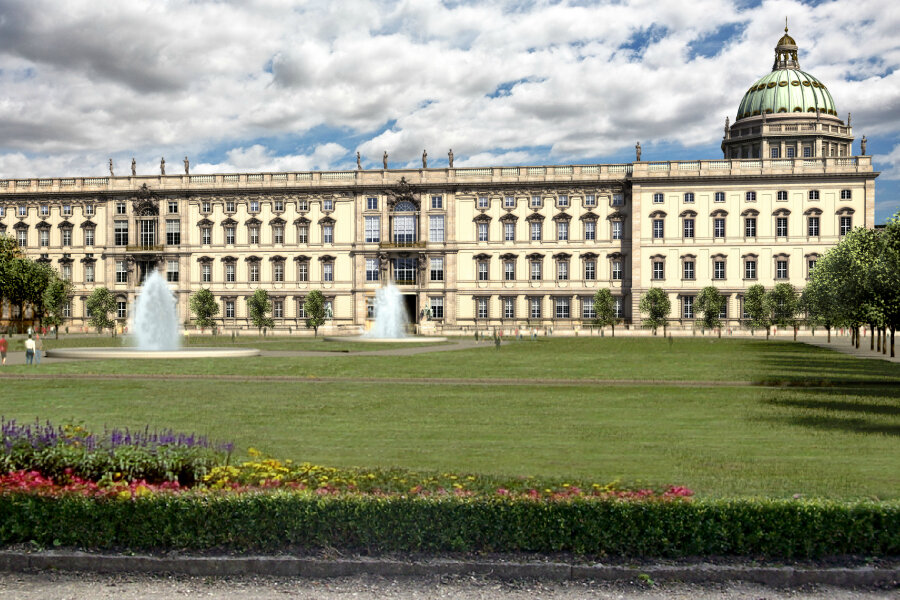Rebuilt palace will again be the historic center of Berlin
Loading...
In September 1950 demolition crews started destroying one of Germany's most historic buildings. The enormous Berlin City Palace took four months to flatten.
Built for the Prussian royal family and added to considerably over the centuries, the baroque schloss, or palace, had been a Berlin cornerstone since 1443 – as much a key part of the city as, say, the Louvre Museum in Paris. But during Allied air raids in 1944 and 1945 it was badly damaged.
Rather than repair it, East German communist leader Walter Ulbricht turned the site – cater-corner to the monumental Berlin Cathedral – into a parade ground.
At that time a young boy in Hamburg, West Germany, learned from his mother that an enormous palace had been destroyed in East Berlin. Wilhelm von Boddien's only thought was what a big noise this must have made. Then, in 1961, as a young man, Mr. von Boddien visited Berlin and saw the site of the palace.
"I found an empty space, a lonesome desert," he says. "I was shocked, sad, disappointed, amazed, and angry."
Although he was only 19, and that part of Berlin was firmly behind the Iron Curtain with the Berlin Wall in the process of being built, a "crazy idea" occurred to him: The Berlin Palace could be rebuilt. Despite its utter impracticality, "the idea was there," he recalls. "I could not get rid of her."
Fast forward to 1991. The Berlin Wall had fallen, Germany reunited, and von Boddien, now a businessman in Hamburg, starts a discussion with some other people who mourned the loss of the palace. These prominent individuals encourage him to act on his dream. So von Boddien began devoting his life to restoring Berlin's historic heart.
In 1992 von Boddien and eight supporters founded the Berliner Schloss Association. In 2002, thanks in no small part to von Boddien's advocacy, the German Parliament approved a resolution to rebuild the palace. Finally, in June 2013, ground was broken. Plans call for the Berlin Palace, with a replicated facade but a modern interior, to open in 2019. Today, von Boddien continues to raise money as managing director of the association.
Inside, the palace will be occupied by the Humboldt Forum, an enormous new center for international art, culture, and science, with museums, a library, and events spaces. Three other major institutions, the Prussian Cultural Heritage Foundation, with collections from around the world; the Berlin Central and Regional Library; and Berlin Humboldt University will together comprise the Humboldt Forum.
Klaus Wowereit, until December Berlin's long-serving governing mayor, has written that "A true place of world cultures will emerge here ... in conjunction with the World Heritage site Museumsinsel."
Museumsinsel – or "Museum Island" – is the grand cluster of museums nearby, for which the Humboldt Forum will provide an anchor.
From the start there have been great obstacles, and controversy. Some people associate the palace with unhappy history: Most notably, a hundred years ago Kaiser Wilhelm II announced the beginning of World War I from a palace balcony. Another issue: The communist government's parliament building – the Palace of the Republic – had been built on the site in the 1970s. Some Berliners wanted to preserve this newer palace.
Finally, there is the issue of the enormous expense. In November the German magazine Der Spiegel published an article suggesting there might not be enough money to complete the palace – a contention von Boddien heartily rejects.
At a cost of almost 600 million euros ($715 million) the German government and city of Berlin are paying to reconstruct the structure of the building. Private money, raised by von Boddien and the Berliner Schloss Association, will restore the ornate baroque facade on three sides, along with the palace dome and other architectural elements. Von Boddien says the association already has raised over 45 million of the almost 110 million euros required.
Several events helped forward the idea of rebuilding the palace. One turning point came in 1993 when von Boddien spearheaded a project where, for a year and a half, a full-scale replica of the palace was created, on canvass, at the site – a move that awakened Berliners to how majestic the palace square once looked.
Then there was the need to remove more than 700 tons of asbestos from the newer palace, which left just the ugly skeleton remaining. Another big lift: agreement to use the building for the Humboldt Forum.
In Berlin's Spandau borough and other locations workers are busy recreating ornate stonework destroyed 65 years ago. When the decorative facade is back in place, the imposing dome again a crown, and the Humboldt Forum installed inside, von Boddien's dream will be complete, and the enormous Berlin City Palace will once again be at the historic center of Germany's capital city.







